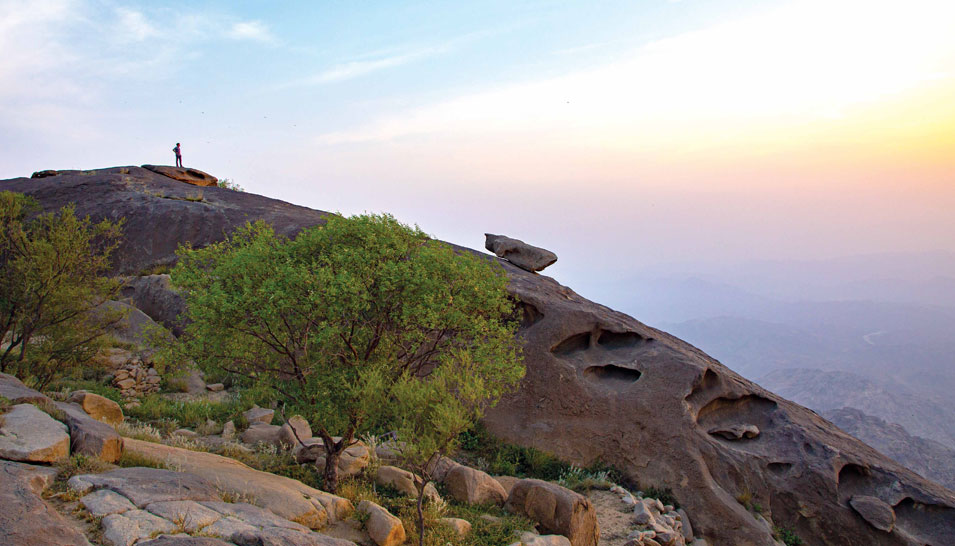by Scott Baldauf

A visitor enjoys amazing views from the top of Shada Al Asfal, one of the two main peaks in the Shada Mountain region. On clear days, it is possible to see the deep blue waters of the Red Sea 60 kilometers away, but even in hazy weather, the views are spectacular.
(Photos by: Scott Baldauf, Lujain Mirza, Fernando Perez, and Gustavo Rodriguez)
On a clear day, you can climb to the top of Shada Al-Asfal and see the deep blue waters of the Red Sea on the horizon 60 kilometers away. But even on a hazy summer afternoon, as the mists blow in from the coasts, the mountains and lush green valleys around Al Baha are breathtaking. It’s no accident that this region is called “the Garden of the Hejaz.”
The past six months of the pandemic have been challenging for all of us, and it’s natural to feel the urge to get out and explore again. But adventurous travelers don’t have to go out of Kingdom to see spectacular sites. For the traveler who likes to scramble up mountains, explore ancient settlements, and get back in touch with natural beauty, Al Baha is a fantastic getaway.

The Hejaz Mountain chain around Al Baha in Saudi Arabia’s southwest is home to a rich and largely untouched alpine ecosystem, with wild baboons, goat and sheep herds, and the brightly colored blue lizard.
It’s easy to forget just how diverse Saudi Arabia’s many landscapes and cultures are. Those who are used to the rolling dunes and oases of the Eastern Province, Al Baha’s cooler temperatures, mountainous terrain, and terraced farmland will come as somewhat of a shock. During the rainy season (from October until the spring), Al Baha’s mountainsides become lush with green vegetation. Rain brings waterfalls to life, and centuries- old irrigation channels bring that water to the terraced gardens and farms that produce the coffee, grains, citrus, mango, and even the honey that have made Al Baha famous.
Our first stop, after touching down at Al Baha’s airport, was a 400-year-old village called Dhy Ain. The town’s name derives from a water spring, or “ain,” that constantly supplies water to the residents and to the fertile fields below with their neat rows of banana trees. The village itself, now recently preserved, is a great place to see stunning examples of the multi-story stone architecture that one finds from Al Baha all the way to the Hejaz mountains into Yemen.

Like their ancestors, villagers in the Shada Mountain region near Al Baha construct homes into the hillsides, with easy access to their terraced farmlands and some of the most stunning views in the region.
From Dhy Ain, we drove up to the remote Shada Mountains. Our destination was a little eco-touristic resort in a lush green farming village toward the top of Shada Al Asfal (Lower Shada). We use this resort as a base camp as our veteran guide, Abu Omar, takes us on hikes up into the mountains to see the cave homes that this region is famous for. For centuries, naturally occurring caves carved out as granite boulders weather and fracture, provided perfect protection for farmers and their families.
While most villagers in these parts have abandoned these traditional homes for more modern concrete structures, you can still find the cave homes with their intricate stone walls and the terraced farm plots where they raised millet and coffee.

The historic village of Dhy Ain (top) is representative of the intricate masonry work of the Hejaz region, and has been lovingly restored for visitors to explore. Higher up in the Shada Mountains, you find cave homes common among farming villagers for centuries (photos 2-3). The rain-fed terraced gardens produce cash crops like coffee as well as honey from wild beehives (photo 4). Visitors to the Shada Mountains can scramble up rugged granite mountains and explore ancient villages.
Our host, Jumaan Al Ghamdi, still raises crops the old-fashioned way, and he gave us a tour of his small but expanding plantation of coffee, limes, bananas, mangos, and fields of millet. A college educated biologist, Al Ghamdi has retained the old practices of channeling and capturing rainwater for his lands. He is also careful to avoid pesticides that could kill off the bees that pollinate his trees and that produce the honey that Al Baha is famous for.
Each evening, we climb the closest peak and watch the sun go down, drinking cups of fresh brewed tea or coffee made on a camp fire. Some brave souls spend the night up here underneath the stars, or in some of the cave homes.
The landscape and the culture of these mountain villages are stunning, and dramatically different from our homes in the Eastern Province. But one thing remains constant: hospitality. Wherever we go, our hosts offer us endless cups of the fragrant golden-colored coffee, fresh baked bread, and mountains of rice and roasted meat that reassures every visitor, they are welcome in Al Baha.
— The Arabian Sun: November 4, 2020 | Vol. LXXV, No. 43